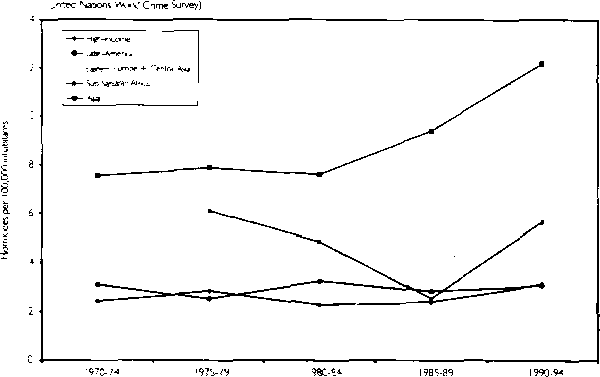Crime as a Social Cost of Poverty
and Inequality; A Review Focusing
on Developing Countries
E Bourguignon
with homicide rates, which probably are more directly comparable across
countries. The latter is close to 5/hti in Argentina, close to 7/hti in Costa
Rica but 14/hti in Venezuela, 18/hti in Mexico, and 20/hti in Brazil, not
to mention the somewhat exceptional case of Colombia with 80∕hti. Here
again, these figures give a severe underestimation of what is going on in
cities. The homicide rate was 80/hti in Rio in 1995 and 52/hti in Caracas,
as opposed to respectively 20/hti and 14/hti for national figures7. The
same is probably true for robbery, Although the following figures are not
comparable to the robbery rates appearing in the UN data base, Londono
and Gucrrcro (1998) report the results Ofvictimization surveys where the
proportion of adults who have been the victims of armed robbery in the
preceding 12 months reached 9 per cent in Rio and 17 per cent in Caracas,
more than ten times the highest police-reported robbery rates in the
region. It is most probable, however, that the definitions of crime used in
these various sources are not fully consistent with each other.
Figure 1b. Evolution of Homicide Rates: Regional Median,
1970-1994

7 Figures for Rio and Caracasare from Londofio and Guerrero (1998).
68
More intriguing information
1. Knowledge, Innovation and Agglomeration - regionalized multiple indicators and evidence from Brazil2. Trade and Empire, 1700-1870
3. I nnovative Surgical Technique in the Management of Vallecular Cyst
4. The Importance of Global Shocks for National Policymakers: Rising Challenges for Central Banks
5. The name is absent
6. The name is absent
7. AN EMPIRICAL INVESTIGATION OF THE PRODUCTION EFFECTS OF ADOPTING GM SEED TECHNOLOGY: THE CASE OF FARMERS IN ARGENTINA
8. Optimal Vehicle Size, Haulage Length, and the Structure of Transport Costs
9. A model-free approach to delta hedging
10. Licensing Schemes in Endogenous Entry